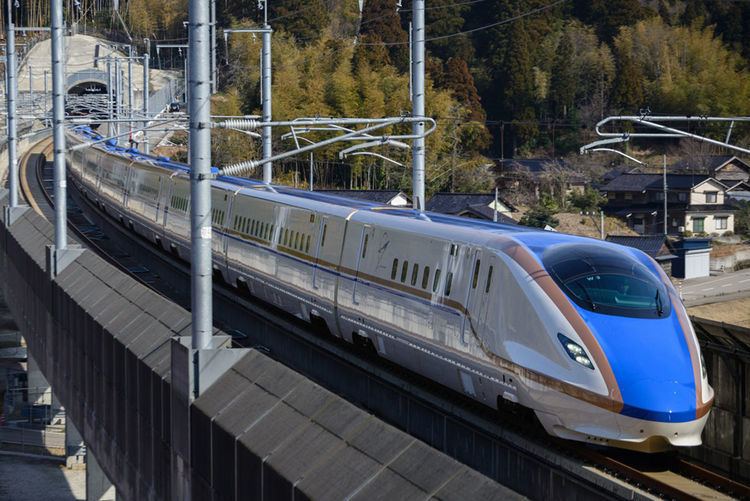In service 14 March 2015 Number built 132 vehicles (11 sets) Formation 12 cars per set | Constructed 2014–2015 Number in service 132 vehicles (11 sets) | |
 | ||
Manufacturer Hitachi, Kawasaki Heavy Industries, Kinki Sharyo | ||
The W7 series (W7系, Daburu-nana-kei) is a Japanese Shinkansen high-speed train type operated by West Japan Railway Company (JR-West) on the Hokuriku Shinkansen since it was extended from Nagano to Kanazawa in March 2015. Jointly developed alongside the similar JR East E7 series, a total of ten 12-car W7 series sets (120 vehicles) have been built. The first W7 series train was delivered in April 2014.
Contents
Design
Based on the earlier E2 series trains, the W7 series trains were designed with a "Japanese" theme inside and out, combining futuristic styling with traditional design elements overseen by industrial designer Ken Okuyama together with Kawasaki Heavy Industries. Externally, the roof is finished in a "sky blue" colour, and the bodysides are "ivory white" with "copper" and "sky blue" lining. The bodyside logos consist of a number "7" in silver stylized as an arrowhead, and include the lettering "West Japan Railway Company".
Manufacture of the W7 series sets was shared between Hitachi in Kudamatsu, Yamaguchi, Kawasaki Heavy Industries in Kobe, and Kinki Sharyo in Osaka.
The trains have a maximum design speed of 275 km/h (170 mph), but in service operate at a maximum speed of 260 km/h (160 mph) on the Hokuriku Shinkansen, limited to 240 km/h (150 mph) on the Joetsu Shinkansen tracks between Omiya and Takasaki, and to 110 km/h (70 mph) on the Tohoku Shinkansen tracks between Tokyo and Omiya. Increased power output enables the trains to maintain speeds of at least 210 km/h (130 mph) on the steep gradients of the Hokuriku Shinkansen.
Car 12 (Gran Class) is equipped with full active suspension, and the other cars are equipped with semi-active suspension.
Operations
Since 14 March 2015, W7 series trainsets are used on Asama, Hakutaka, Kagayaki, and Tsurugi services alongside JR East E7 series trains.
Formations
The 12-car sets are numbered "W1" onward, and consist of 10 motored ("M") intermediate cars and two non-powered trailer ("T") end cars, as shown below. Car 11 provides Green car (first class) accommodation, and car 12 provides Gran Class luxury accommodation.
Cars 3 and 7 are each equipped with a single-arm pantograph.
Interior
The 12-car trains have accommodation in three levels of service: Gran Class, Green, and ordinary-class cars, with a total seating capacity of 934. Gran Class seating (car 12) is arranged 2+1 abreast with a seat pitch of 1,300 mm (51 in), Green car seating (car 11) is arranged 2+2 abreast with a seat pitch of 1,160 mm (46 in), and ordinary seating (cars 1 to 10) is arranged 3+2 abreast with a seat pitch of 1,040 mm (41 in). AC power outlets are provided for each seat in all three classes. The Gran class seats are supplied by Toyota Boshoku. Car saloons and vestibule areas are equipped with security cameras. Between October and December 2015, luggage racks are scheduled to be added at one end of each of the even-numbered ordinary class cars and also in Green car 11, by removing a pair of seats (1D and 1E). The luggage racks are to cater to the increased number of overseas tourists with suitcases and also passengers with ski and snowboard equipment in the winter season.
History
In January 2012, the head of JR-West's Kanazawa Division revealed that new trains for the Hokuriku Shinkansen would be developed in conjunction with JR East, and that test running would need to be conducted during the winter season a year before the line opening to thoroughly test the ability of the trains to cope with snowy conditions. Details of the new trains were formally announced jointly by JR East and JR-West on 4 September 2012. The design of the logo to be applied to the sides of cars 1 and 12 was officially unveiled in February 2014.
The first W7 series train was delivered from Kawasaki Heavy Industries in Kobe to Hakusan Depot in Hakusan, Ishikawa in April 2014. Test-running on the Hokuriku Shinkansen began on 5 August 2014, initially at low speed, between Kanazawa and Jōetsumyōkō.
In April 2015, JR-West announced that it was ordering an additional E7 series set to be introduced from autumn 2015, replacing the remaining E2 series trainsets used on regularly scheduled Hokuriku Shinkansen Asama services.
In May 2015, the W7 series and JR East E7 series were awarded the 2015 Blue Ribbon Award, presented annually by the Japan Railfan Club. A presentation ceremony was held at JR-West's Hakusan Depot on 24 October 2015.
The W7 series is the first JR-West train type to use the "W" prefix, following the method used by JR East (with an "E" prefix).
Fleet list
As of 1 October 2015, the fleet is as follows.
